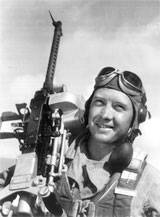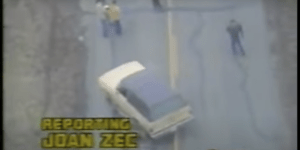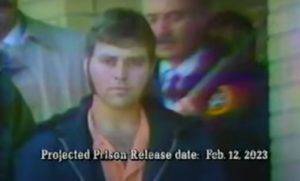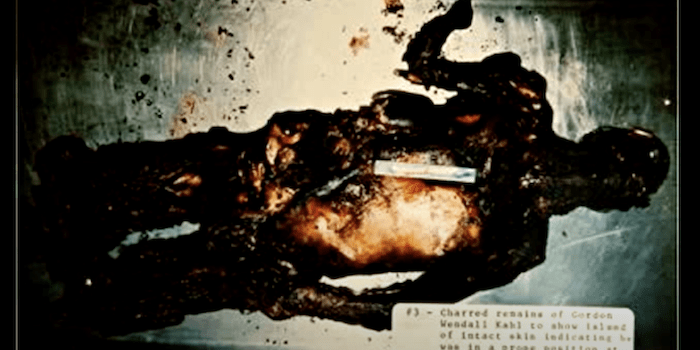(Ken Silva, Headline USA) On this date 40 years ago, the FBI and U.S. Marshals were encircling fugitive Gordon Kahl in rural Lawrence County, Arkansas.
A tax protestor who killed two U.S. Marshals in a shootout, Kahl would purportedly be classified as America’s first right-wing domestic terrorist by the FBI. The bureau certainly treated him as such on June 3, 1983, when agents poured thousands of rounds of ammunition into Kahl’s “safe house” before burning it to the ground with him inside.
But records and witnesses in the Kahl case tell a story that runs counter to the U.S. government’s narrative. Far from being a legitimate counterterrorism operation, a closer examination of the Kahl case reveals evidence suggesting that overzealous federal agents targeted the farmer over a paperwork issue, and then murdered and mutilated him after he defended himself and his family.
As the U.S. government views right-wing dissidents increasingly as terrorist threats 40 years later, Headline USA examines how Kahl started it all.
The Saga of Gordon Kahl
Born in North Dakota in 1920, Kahl served in the Pacific theater of World War II and was highly decorated—participating in 57 bombing missions and earning four Bronze Stars, a Silver Star, two Purple Hearts and a Presidential Unit Citation.

But upon his return to civilian life as a farmer in North Dakota, Kahl became concerned with what he perceived to be a country drifting into communism. He was particularly alarmed that federal tax dollars were funding abortions.
In 1969, Kahl wrote a letter to the IRS, informing agents that he would no longer be making payments to “the tithe collectors of the synagogue of Satan.”
The IRS ignored Kahl at first—the farmer didn’t “owe” any taxes—but took notice when he began appearing on public access television in the mid-1970s, urging others to follow him in resisting the income tax.
Kahl was convicted of willful failure to file federal income tax returns in 1976, and was sentenced to two years imprisonment in Midland, Texas. There, he suffered two heart attacks, while his fellow tax protestor, W.M. Rinehart, had a fatal heart attack in another jail.
Believing that the U.S. government purposely poisoned him and Rinehart, Kahl vowed to never again return to prison.
Kahl had a warrant issued for his arrest for a parole violation soon after his release from prison. But law enforcement agencies sat on the warrant for about two years, until February 1983.
It’s still not clear why the government decided to enforce the warrant when it did. Some have suggested that overzealous U.S. Marshals wanted to make a high-profile arrest, while the more conspiratorial-minded think there was a plan at the highest levels of the DOJ to make an example out of Kahl.
Author Pat Shannan, who wrote extensively about the Kahl case, told Headline USA he thinks the decision to enforce the warrant was a combination of the two.
Shannan explained that the government had been spying on Kahl for more than a year prior to 1983. But he said the presence of an ambitious new U.S. Marshal—the prior Marshal got along well with Kahl, and declined to arrest him over what amounted to a paperwork issue—was likely the impetus for what came next.
And what came next was a shootout that captured national attention.
On Feb. 13, 1983, Kahl and several family members and friends were leaving a community meeting about the farming crisis—about three farms per day were closing in North Dakota at the time, due in large part to skyrocketing interest rates that left farmers unable to obtain loans.
Exiting the sleepy town of Medina, North Dakota, the Kahls spotted flashing lights from a police road block about a mile ahead. They tried turning around to find another route, but an unmarked Dodge Ram pulled up behind them to prevent their escape.
Gordon Kahl, his son Yorie Kahl and their friend Scott Faul left their vehicles with Ruger Mini-14 rifles in hand, while wife Joan Kahl hunkered down inside one of the cars. Several U.S. Marshals and local police arrived on the scene, and a standoff ensued.

After several minutes, what sounded like a gunshot sounded through the North Dakota plains, sparking a gunfight. Who shot first is still in dispute—though, as former Medina Police Chief Darrell Graf pointed out, this question is legally a moot point, as law enforcement had the right to fire once the Kahls pointed their rifles at the officers.
In any event, Yorie was hit twice. Gordon claimed credit for killing two U.S. Marshals in return, and for wounding Medina police officer Steve Schnabel.
After fleeing the scene and dropping his son, Yorie, off at the hospital, the elder Kahl and Faul were on the lam. Hiding that night inside an abandoned barn, Kahl planned to make way for Arkansas, while Faul stayed behind and decided to surrender to authorities.
Kahl’s escape added to his legend.
A heavy fog settled on the Medina area as Kahl travelled on backroads to evade detection, which prompted some in the Patriot Movement to believe Kahl had help from the Big Man upstairs.
“It was not unlike the divine protection George Washington experienced in New York in 1776, when his surrounded troops escaped across the East River,” Shannan, who spoke to Headline USA for this story, said of Kahl’s escape.
Kahl made it to Arkansas, receiving shelter in the homes of various patriot compadres throughout the state.
But aided by its shadowy network of informants, the FBI’s dragnet was closing in on him.
On June 3, 1983, the FBI finally tracked down Kahl to a “safe house” owned by Leonard and Norma Ginter in rural Lawrence County.
Accounts vary about what happened that day.
According to the U.S. government, a local sheriff and a U.S. Marshal entered the home to arrest Kahl. Another shootout ensued, with Kahl and the sheriff hitting each other simultaneously.
After that, the sheriff allegedly stumbled out of the house and notified the other agents and officers that he shot Kahl. Worried that Kahl may have survived, FBI agents and U.S. Marshals fired thousands of rounds into the house, poured diesel fuel down its chimney and ignited a fire—supposedly out of fear that Kahl could have been hiding in a non-existent labyrinth of tunnels beneath the structure.
Forensic evidence and witnesses tell a story that runs counter to government’s narrative.
For starters, then-Medina Police Chief Darrel Graf said he overheard U.S. Marshals and FBI agents arguing the day after the shootout about who would get the privilege of killing Kahl once they found him.
“The Marshal argued, ‘He killed two of ours, so we get to kill him.’ The FBI agent replied, ‘If you kill him, the public won’t go for it. It will look like revenge. If we kill him, it will look like another gun battle,’” Graf wrote in his book, It’s All About Power: A True and Accurate Eyewitness Account of the Shootout Between Gordon Kahl and U.S. Marshals.
“I stood up from behind my desk and told them to calm down and think about what they were saying. It got very quiet in the room at that point. It was obvious to me that Gordon Kahl was a dead man! Simply arresting Gordon was not part of the Fed’s game plan.”
Leonard Ginter, who was present at the June 3 siege of Kahl’s safe house, also thought federal agents murdered Kahl, as well as the local sheriff. Ginter said he heard a single shot from within the home, followed by five or six others in rapid succession.
An autopsy showed that Kahl was shot a single time, from a downward angle in the back of the skull. Some skin on his charred body remained intact, suggesting to some that he was in a prone position when he was shot.
This led Ginter and others to believe that the U.S. Marshal murdered Kahl execution-style, killed the local sheriff to eliminate any witnesses, and then conflagrated the home to destroy the remaining evidence.
Yet more evidence of this was discovered weeks later, when Kahl supporters were walking through the concrete shell of the burnt-out home. While doing this, someone discovered Kahl’s severed foot—contradicting the U.S. government’s claims that Kahl’s hands and feet were disintegrated in the fire.
Shannan told Headline USA that he believes the U.S. Marshal initially thought he had killed the wrong person—and cut off the person’s limbs to get rid of fingerprints and other identifying markers. Supporting this theory is the fact that a nearby neighbor, Bill Wade, who closely resembled Kahl, was initially reported to be dead after the siege.
Regardless of whether the U.S. government purposely murdered Kahl, his supporters certainly thought that to be the case.
Backlash
Kahl’s death sparked a right-wing backlash that spiraled out of control.
A legitimately terroristic group known as The Order was formed later in 1983, going on to assassinate a Jewish radio host and rob millions of dollars from banks with the goal of funding a right-wing insurgency. The group’s leader, Bob Matthews—whom the FBI also killed and conflagrated in December 1984—cited Kahl’s murder in a declaration of war he drafted against the federal government.
The Order, in turn, served to bolster the FBI’s domestic terrorism resources. The bureau eventually launched an undercover operation called Patriot Conspiracy, or PATCON, which was involved in Ruby Ridge, Waco and the Oklahoma City bombing.
And today, the same counterterrorism apparatus is used to target militias, election protestors, activist parents and other right-wing or libertarian dissidents.
All this began with Kahl. According to former Medina Police Chief Darrel Graf, the FBI classified the tax-protesting farmer’s case as the first ever instance of right-wing domestic terrorism.
“I happened to be in a fire-fighting school in Nevada [in 2004], and part of the class entailed putting out oil fires set by terrorists. We’re talking about groups like the Earth Liberation Front,” Graf said on a podcast several years ago.
“Well, at any rate, they gave us a handout. In this handout, according to the FBI, the first right-wing terrorist act on the United States was in 1983 in Medina, North Dakota.
“And I about came unhooked.”
Meanwhile, Kahl’s son Yorie and friend Scott Faul are still imprisoned.

Yorie’s presumptive release date was February of this year, but he has continuously been denied parole—apparently because he hasn’t shown remorse. Faul faces a similar situation, though he recently filed a writ of habeas corpus over the matter.
Shannan said he unfortunately believes that the U.S. government will keep Yorie and Scott imprisoned for the rest of their lives.
“It’s a Satanic sacrifice,” he said. “It’s absolutely Satanic.”
Ken Silva is a staff writer at Headline USA. Follow him at twitter.com/jd_cashless.

